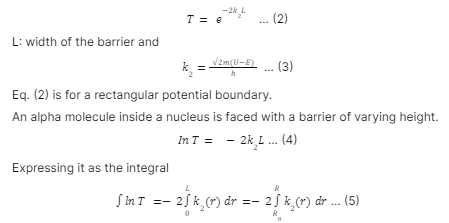The association between the energy of an alpha particle created and the decay constant for a radioactive isotope is portrayed by Gamow Hypothesis or Geiger-Nuttall guideline. It was made in 1911 by John Mitchell Nuttall and Hans Geiger. This standard shows that more restricted lived isotopes communicate more energy.
Energy of alpha particles radiated during alpha decay:
AAZ → A-4GZ-2 + 4He2
From conservation of mass-energy
MA C2 = MG C2 + Mα C2 + kG + kα,
MA: Parent atom mass, Mg=G: Daughter atom mass
kG: Daughter atom kinetic energy, kα: α particle kinetic energy.
Here, we have assumed that the parent atom is at rest.
(Disintegration energy) q = kG + kα = [MA – (MG + Mα)] c2
Conservation of linear momentum demands
Mα Vα = MG VG. (1)
VG: daughter atom speeds, Vα: alpha particle speed.
kα = Mα Vα 2/2, kG = MG VG 2/2
Substituting for VG from Eq. (1)
kG= MG (Mα Vα /MG) 2 /2 = Mα Vα 2 (Mα /MG)/2
MG kG = Mα kα
q = kG + kα = kα (1 + Mα / MG)]
Since, Mα = 4 and MG = B-4, kG = (4/(B-4)) kα
q = kG + kα = (B/(B-4)) kα
kα = ((B-4)/B) q kG = 4 q / B
A of nearly all alpha emitters exceed 210.
Therefore, B-4 is approx. B, kα = q and kG approx. 0.
Gamow’s theory of alpha decay derivation
Gamow’s theory of alpha decay derivation explains the phenomenon of alpha decay. Gamow made the following assumptions:
An alpha particle may exist as an alpha particle heavy nucleus.
An alpha particle is in constant motion and is held in the nucleus by a potential barrier.
The alpha particle may tunnel through the barrier each time it collides with the barriers.
Gamow derived the relation for probability based on these assumptions.
The decay probability per unit time, λ, can be expressed as:
λ = ν T
ν: no. of times each second an alpha molecule inside a nucleus strikes the possible hindrance
T: the probability that the particle will be transmitted through the barrier
If we have a tendency to suppose that at any moment, only 1 particle exists per se during a nucleus, which moves back and forth on a nuclear diameter,
(Collision frequency) v= v2R0
𝑣: alpha-molecule speed when it ultimately leaves the nucleus. R0: radius of nuclear.
Values are: 𝑣 = 2 x 107 m/s ; R0 = 1014 m ; ν = 1021 s-1
The alpha molecule thumps at its keeping divider 1021 every second; however, it might have to sit down tight for a traditional 1010 y to escape from a certain nucleus.
An approximate value of the transmission probability.
T= e-2k2L … (2)
L: width of the barrier and



Uses:
Used as a Smoke Detector.
Used for production of Natural Helium.
Used in the Alpha Particle X-Ray Spectroscopy.
Used in different Medical Equipments.
Used as Static Eliminator.
Many Heating Devices made from alpha decay.
Used in space research as Spacecraft Power Source and Pacemaker Battery.
Used in many Remote Sensing Stations.
Also used in the field of Geology as Seismic and Oceanographic Devices.
Conclusion:
George Gamow (from Odessa, Ukraine) had tackled the theory of alpha decay through burrowing by 1928. The nucleus traps the alpha molecule in a potential well. Getting away has traditionally been illegal. However, according to quantum physics’ novel norms, it has a low probability of “burrowing” past the hindrance and appearing on the other side.
 Profile
Profile Settings
Settings Refer your friends
Refer your friends Sign out
Sign out






